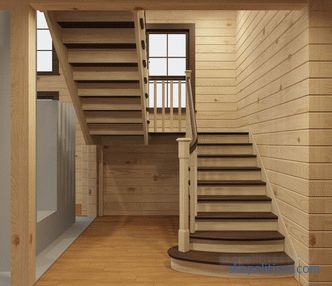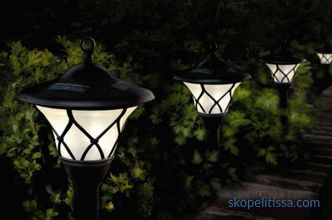Geotextile products will help improve the appearance of your site. The article describes the varieties of the canvas, due to the method of production and raw materials, as well as its functions and benefits of use. You will get acquainted with the possibilities of application, the nuances of choice and the cost of geotextiles, which you can buy after comparing the options offered by manufacturers.
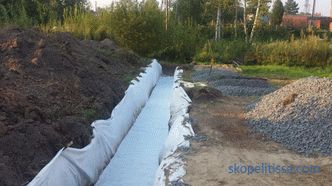
About the application and functions
Geotextiles are an artificial material, developed and launched into production in France in 1968 (our production began in 1977). Durable technical canvas has become widely used in various fields, from agriculture and gardening and construction, to medicine and landscape works. The canvas performs several functions, including:
-
Splitting . Geotextiles prevent mixing and displacement of layers of bulk materials, making the design more stable.
-
Filtering . The material has a homogeneous structure with excellent filtering qualities, which does not clog the drainage pipe. Soil particles are not able to penetrate the geofabric, so that the soil is not washed out and does not mix with rubble.
-
Strengthening of the soil . Geotextiles are able to redistribute the load of the soil on the problem area (for example, on a steep slope or retaining wall), thereby enhancing its carrying capacity.
-
Protection . The canvas is able to protect materials of construction from accidental damage; for example, insulation in a green or inversion roof, or waterproofing a pool from a root or stone.
About types of geotextile products
The canvas is obtained from various raw materials and with the help of several technological processes. Due to this, the varieties of geotextiles on the market differ in properties and method of application; It can be divided into three types:
-
Polypropylene . The fiber from the primary material is drawn into a continuous thread, which gives the material particular strength. The canvas is characterized by a dense homogeneous structure, permeability and ability to filter. It is resistant to rotting and the effects of chemical compounds, successfully performs its functions under difficult conditions (with strong soil pressure and vibration). The material is successfully used in the construction of a modern roadway. Color - white or gray (if the composition includes additives that protect against ultraviolet radiation).
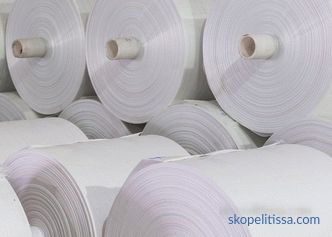
-
Polyester . It is made of products of processing (for example, household plastic). The canvas consists of short fibers forming a fleecy structure; the parameters are slightly inferior to the material produced from polypropylene, and therefore has a narrower scope. Different grades may be gray, beige, black, brown,
-
Blended geotextiles . Complex composition with the addition of secondary raw materials (viscose, cotton, wool). A more budgetary, but unreliable option: the natural fibers that make up the composition begin to break up after a while, reducing performance.

types of material:
-
Woven geotextiles (geofood ). It is made, as usual fabric, on technology of an interlacing of threads from polyester fibers that allows to regulate density of a material. It has many advantages, including a long service life and high tensile strength. High-strength woven geotextiles are laid at the base of highways and railways, hydraulic structures, and runways. Low strength material suitable for landscape design tasks. Geofabric, which you can buy from a wide number of manufacturers, is suitable for strengthening walkways, soil on the slopes, drainage device.
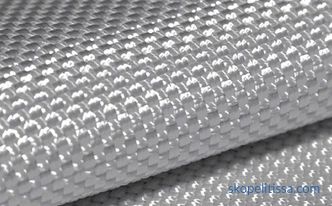
On our site you can find the contacts of construction companies that offer the service of landscape works. You can directly communicate with representatives by visiting the low-rise country exhibition.
-
Non-woven needle-punched geotextile . Threads are threaded through the fiber base with special needles, fastened mechanically. The resulting material is characterized by excellent filtering ability in any direction, which is ideal for use in drainage systems.Due to its good elasticity and strength, it is readily used during landscape and road construction works, during the construction of the foundation and roof.
-
Nonwoven thermally bonded geotextiles . Fibers are fused into a fabric by thermal method (when heated), for which only polypropylene raw material is suitable. The advantages of the material are mechanical strength and elasticity, resistance to acids, alkalis and ultraviolet radiation, as well as significant (20-25 years or more) service life. It is used where it is necessary to evenly distribute the load and fix the layers - in the roadway, in drainage systems and hydraulic structures, in landscape works. Minus - partial filtration (passes water only in the transverse direction).
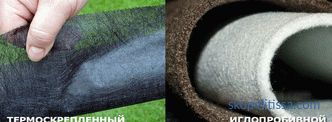
-
Geofeed . Knitting and sewing material is made by domestic technology. It is characterized by low tensile strength and, in spite of quite budgetary cost, is not very popular.
On our site you can find contacts of construction companies that offer the service of reconstruction and reconstruction of houses. You can directly communicate with representatives by visiting the low-rise country exhibition.
The advantages of using
The growing popularity of geotextiles is explained by its advantages, including the following qualities:
-
Low Cost . The result of a combination of simple technology and cheap raw materials. Average prices for 1m 2 canvases vary in the range of 15-25 rubles. An additional plus is the use of geofabric reduces the expense of construction workers, and hence the budget of work.
-
Durability . Service life reaches 25-30 years (depending on technical characteristics). The reduction in filtering capacity is due to the fact that the pores of the material are gradually filled with soil particles.
-
Reliability . Fiber fabrics have good elasticity and tensile strength. Significant load can cause deformation (fibers can be extended by 30-40%), but the fabric continues to perform its functions.
About the varieties of geotextiles in the following video:
-
Versatility . A variety of areas of use is caused by a combination of technical parameters of geotextiles - strength, elasticity and permeability.
-
Environmental friendliness . Geotextiles are safe for humans and the environment because they do not emit harmful substances.
-
Simple use . The material is easy to transport (sold in rolls), it is easy to cut and stack.
Possibilities for use in home gardens
Geotextiles have been used not only in the construction of large-scale road and public construction projects. The canvas is successfully used by the owners of country plots for solving a variety of tasks:
-
Arranging strong garden and driveways . The use of geotextile, which separates the soil layer from the sand-gravel pad, reduces the consumption of bulk material and distributes the load, preventing the tracks from sagging in the future. In parallel, soil erosion slows down, and weeds cannot grow through the geotextile layer.
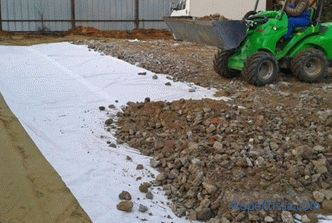
This can be interesting! In the article on the following link read about the technology of arrangement of garden drainage.
-
Strengthening of the soil . In the construction of a sports ground or an automobile ground, the material plays the role of a reinforcing layer (it is especially important for problem soil with a weak bearing capacity). It prevents subsidence of soil and shedding slopes.
-
Breakdown of lawns, flower beds and flower beds . The material separates the layers, preserving the fertile soil layer from destruction and preventing the weeds from clogging the lawns. Additionally, the growth of the root system of trees slows down.
-
Drainage device . Without geofibre not to do on the site with a high level of groundwater. In this case, geotextiles play the role of a filter, preventing the soil from penetrating into the drainage pipe. Drainage sewage will work more efficiently and longer if you choose the fiber of the correct density, 100-200 g / m 2 .
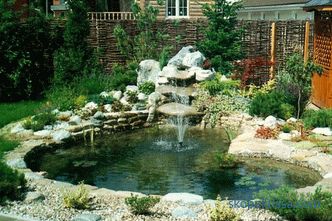
It can be interesting! In the article on the following link read about the features of sports lawns.
-
Creation of artificial ponds (pond, basin, waterfall). Geotextiles serve as waterproofing protection; the density of the material should be high, at least 250-300 g / m2.
-
Inversion and green roof arrangement, blind area .Geotextile is a mandatory component of the roofing pie, it is recommended to be used to protect the foundation from the harmful effects of water.
About the choice of the canvas by density in the following video:
Selection
When thinking about where to buy geotextiles, it is fundamentally wrong to focus only on the cost of the material. In order to purchase was not in vain, and the canvas was able to bring the maximum benefit, you should pay attention to several parameters. An important indicator is the density of geotextiles, which determine the load on which the material is designed, the degree of permeability and elasticity. Based on the type of work carried out at the site, the density of the canvas can be divided into the following groups:
-
Up to 100 g / m 2 . It is used for arranging greenhouses and greenhouses, to protect seeds from birds (after sowing).
-
From 100 to 200 g / m 2 . Filter drainage system, weed control, simple landscape works.
-
From 250 to 300 g / m 2 . The main landscape works: the device of decorative slopes and artificial reservoirs, garden paths and flower beds.
In private construction, more dense (and expensive) geotextiles are practically not used; A universal option is a material with a density of 200 g / m 2 .
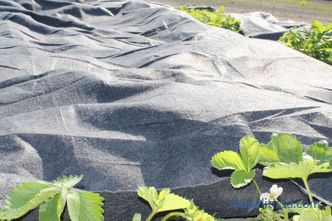
In addition to strength, the following parameters also affect the quality of geotextiles:
-
Manufacturing method and raw material composition.
-
Specifications . Burst load, frost resistance and filtration coefficient.
This can be interesting! In the article on the following link read about the pond at the country site.
Cost
The cost of geotextiles is determined by the following factors:
-
Type of polymer . Cloth of polypropylene fibers is more expensive than polyester.
-
The quality of raw materials . Primary polymer raw materials are more expensive than recycled materials obtained from plastic bottles.
-
Method for producing web . Needle punched geotextiles are cheaper than other varieties.
-
Density . The higher the density, the more expensive the material.
-
Availability of additives . Some varieties contain an ultraviolet protection additive.
-
Roll Size . On the market are rolls with a width of 2 to 5.2 m, with a winding of 25-110 meters.
About the correct drainage for the suburban area in the following video:
When performing this or that work on the section, the owner faces with the need to buy geotextiles; the price for various brands is as follows:
-
Dornit , 100 g / m 2 , roll length 50-100 p. m., width 2-6 m. Price from 14.5-21.5 rubles. / m
-
Dornit , 200 g / m 2 , width 2-6 m. From 19.5-22.5 rub. / m
-
Dornit , 250 g / m 2 , width 2-4.2 m. From 23.5-24.5 rubles. / m
-
Dornit , 300 g / m 2 , width 2-4.2 m. From 28.5-29.5 rubles. / m
-
Geotextile needle-piercing G-Tex (50 m2). From 1000-1080 rubles.
-
Universal geotextile Dornitex , roll 52.5 m, from 1200-1250 rubles. /PC. (density 100). From 1450-1500 rub. /PC. (density 150).
-
Geotextile Megaizol GEO Garden , 80 m 2 , from 1100-1150 rubles.
-
Megaizol GEO PRO 300 , 50 m 2 , from 2200-2250 rubles.
-
Non-woven Geotex , density 200, from 35 rubles. / m 2 .
-
Non-Woven TechnoNIKOL Tech Prof PET , density 300, from 65 rubles. / m 2 .
-
Woven Ecospan Geo building , from 52-55 rubles. / m 2 .
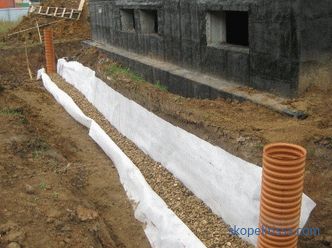
This can be interesting! In the article on the following link, read about a floating island with a live tree in Copenhagen harbor.
Conclusion
Every year, geotextiles are increasingly used in the improvement of homestead lands. The practicality of the material was appreciated by the owners of suburban areas located near water bodies or on difficult terrain, in places with overmoistened or sandy soil. In order for the use of the web to be justified, it is necessary to choose material from proven manufacturers that is effective for the work ahead (purchasing reinforcing material where filtering is needed will be inappropriate). To protect yourself from counterfeiting, you should pay attention to the availability of certificates, factory labels and instructions.
Rate this article, we tried for you
